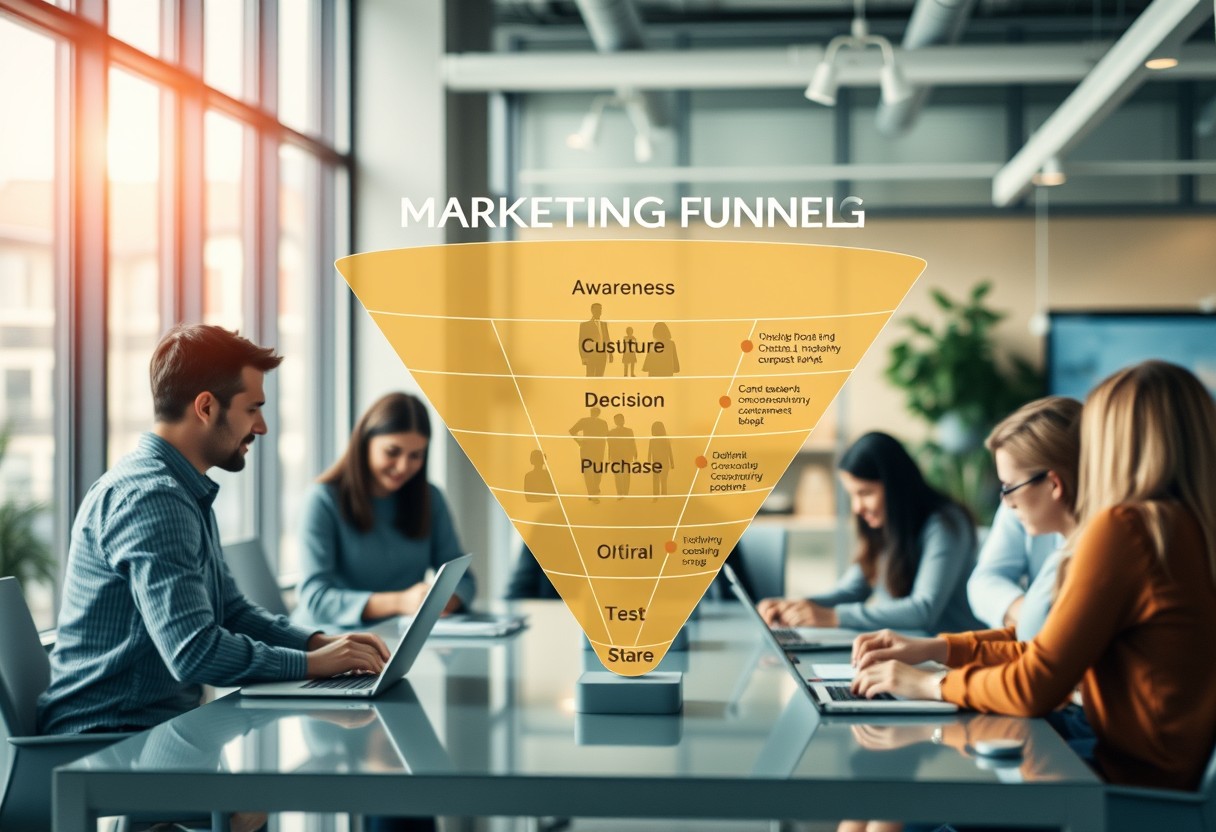Just think about how many times you’ve scrolled through your feed, grabbed a snack, or impulsively bought something online. Your audience is no different! Building an effective marketing funnel means crafting a journey that takes your potential customers from a casual glance to hitting that ‘purchase’ button. In this post, we’ll break down the steps you need to take to guide your audience, nurturing their needs while boosting your bottom line. Let’s dive in and transform your marketing strategy into a powerhouse of conversions!
Understanding the Marketing Funnel
The marketing funnel is like your customer’s personal GPS – guiding them from the moment they first hear about your product or service to the instant they hit ‘buy’. It’s a roadmap that helps you navigate the complex journey of potential customers, breaking it down into stages where each step demands a distinct approach. You’ve got to understand that every interaction matters, and your job is to facilitate the process, keeping your audience engaged and moving forward. By dissecting this funnel, you’re not just selling; you’re building relationships that can convert into loyal customers.
The Stages of Awareness
Any successful marketing funnel has to start with awareness, and that’s where you need to create buzz around your brand. You want potential customers to discover who you are and what you offer, whether it’s through social media, search engine results, or word of mouth. This stage is all about capturing attention. You’ve got to stand out in a crowded marketplace, and that means your content has to resonate, intrigue, and pull them in. Think about how you can present your value proposition clearly and engage their curiosity, so they want to know more.
Importance of Engagement
By fostering engagement throughout the funnel, you’re building a bridge of trust and interest with your audience. This isn’t just about making a sale; it’s about creating a conversation. When you actively engage with your potential customers, you’re not only addressing their questions and concerns but also demonstrating that you value their inputs. Your goal should be to cultivate a community where prospects feel heard and understood, making them more likely to convert into paying customers down the line.
It’s not enough to just toss content at your audience and hope they buy in. You’ve got to actively create touchpoints that spark discussions, answer questions, and build that rapport. Engagement can take many forms – comments on social media, emails, live chats, or even workshops. Every interaction is an opportunity for you to showcase your expertise and authenticity, and to connect on a genuine level. When people feel that connection, they’re way more inclined to take the next step in your funnel, from interest to engagement, and ultimately, to purchase. So get ready to dive in and make those connections count!
Crafting Compelling Content
Clearly, the content you create becomes the heartbeat of your marketing funnel. Each stage—from awareness to decision—demands tailored messaging that resonates with your audience. You’ve got to think about your buyer’s journey and what they need at every step. Awareness content could be engaging blog posts and eye-catching social media updates, while consideration content might include detailed guides and case studies that establish your credibility. (Your decision on the type of content you produce here will significantly impact customer engagement.)
Content for Each Funnel Stage
Behind every effective marketing funnel lies an understanding of the diverse content types needed for each stage. At the top, you aim to gain attention; you need catchy headlines and shareable visuals that spark curiosity. As potential customers move downward, focus on providing value through in-depth insights, comparisons, and solutions to their pain points. By the time they reach the bottom of the funnel, they’re ready to commit, and that’s where testimonials, product demos, and strong calls-to-action come into play. (The right content alignment with their stage will make your funnel not just a pathway, but a magnet for conversions.)
Storytelling Techniques
By weaving storytelling techniques into your content, you can profoundly connect with your audience. Stories are memorable and evoke emotions—they create a bridge between your brand and your potential buyers. Use anecdotes, challenges, and inspirations to craft a narrative that reflects your brand’s values. It makes your message relatable and human, allowing customers to see themselves within your journey. (This is all about making sure your audience feels something when they interact with your content.)
Even the best stories require structure and intention, so don’t shy away from using techniques like character development and conflict resolution. Paint a picture where your audience can envision their challenges and see your brand as the hero that solves them. This sets a tone of authenticity and trust. (Your commitment to storytelling can elevate your content from simple words on a page to memorable experiences that compel your audience to take action.)
Leveraging Social Media
While you’re navigating the world of digital marketing, social media stands out as a potent tool to fuel your marketing funnel. It’s not just about being seen; it’s about becoming a part of the conversation in your industry. Social platforms like Facebook, Instagram, LinkedIn, and Twitter allow you to reach potential customers at the top of your funnel and create meaningful connections that can lead them through to a sale. If you’re not actively engaging on social media, you’re missing out on a rich opportunity to showcase your brand personality and establish a genuine relationship with your audience.
Building Awareness with Social Platforms
The first step to guiding your customers down the funnel is by building awareness. This is where your creativity shines through. Use eye-catching visuals, engaging stories, and persuasive calls-to-action that speak directly to your target audience. Share content that resonates, whether it’s an informative blog post, a fun behind-the-scenes video, or a captivating infographic that highlights your product’s benefits. Every single piece of content is a chance to get noticed and spark interest. Just be authentic; people can sniff out a gimmick from a mile away, and they want to connect with real, relatable brands.
Nurturing Leads through Community Engagement
One of the most effective ways to nurture leads is through community engagement. When you build a community around your brand on social media, it’s like having a group of loyal advocates who are ready to amplify your message. Foster two-way conversations by responding to comments, asking questions, and encouraging your audience to share their experiences with your products. You don’t want to just broadcast; you want to create dialogue. (Engaging with your community can significantly boost your conversion rates and influence customer loyalty.)
A simple post asking for feedback or a poll about future products can provide you with invaluable insights while making your audience feel valued and heard. This ongoing engagement keeps your brand top-of-mind and turns casual viewers into loyal followers. As you invest time in nurturing these relationships, you’re not just selling; you’re creating a tribe that believes in what you do. (Your approach to community engagement can dramatically change your customers’ journeys from leads to buyers.)
Utilizing Email Marketing
Keep your focus on building a strong email list, as it’s your ticket to nurturing relationships with potential customers.
Building an Email List
The first step is enticing your audience to subscribe. Offer value—whether it’s exclusive content, discounts, or insights that they can’t get anywhere else. You’ve got to show them that engaging with you through their inbox is well worth their time. (Finding the right incentive is key here.) Once they’re on your list, you’ll have the power to guide them deeper into your funnel, all while leveraging the trust you’ve built with them.
Any effective email marketing campaign needs solid strategies that cut through the noise.
Email Campaign Strategies
You want to segment your audience for personalized messaging, ensuring that each subscriber feels like you’re speaking directly to their needs. Craft engaging subjects, hook their interest, and provide content that pushes them towards conversion. (Testing different strategies is crucial to optimize your approach.) As you analyze the metrics, be ready to pivot and adapt your strategy based on what resonates with your audience. Embrace the data—it’s your roadmap for future campaigns.
To take your email marketing to the next level, think about automating your campaigns. Set up drip sequences that lead your subscribers through a journey, addressing their pain points at each step. This hands-free approach allows you to deliver timely content without always being glued to your screen. (Smart automation not only saves you time but also enhances customer experience.) Focus on refining your messaging and always provide value—after all, you want them to feel that it’s a privilege to be on your email list instead of just another marketing ploy.
Optimizing Conversion Rates
Despite all the effort you put into your marketing funnel, it’s the conversion rates that ultimately measure your success. You need to constantly tweak and refine your strategies to ensure that you’re not just attracting potential customers but actually converting them. It’s about understanding what resonates with your audience, eliminating friction points in their journey, and making the purchase process as smooth as possible. Dive deep into the analytics, see where people are dropping off, and don’t be afraid to get creative with tweaks to your landing pages, call-to-action buttons, or email campaigns.
Analyzing Customer Behavior
About knowing what customers truly think and feel as they navigate your marketing funnel. You can’t just throw darts in the dark and hope for the best. Use tools like heat maps, session recordings, and analytics to gain insight into how your audience interacts with your content. Focus on key metrics, like bounce rates and time on page, to gauge customer engagement. The more you understand their behavior, the better equipped you are to make the changes needed to guide them smoothly from awareness to that all-important purchase.
A/B Testing and Iteration
Around every corner of your marketing strategy, there’s always room for improvement. A/B testing is your golden ticket to vastly enhancing your conversion rates. It’s not just about making big leaps; small adjustments can yield impressive results. By comparing two different versions of a webpage, email, or even an ad, you can see which resonates more with your audience. Don’t guess what works—test it! Keep iterating based on real data, and you’ll create a winning formula that captures attention and cash.
But here’s the thing: A/B testing isn’t a one-and-done deal. It’s an ongoing process that gives you valuable insights. Even if one version performs better, you can and should continue testing different variations over time to stay ahead of the game. Marketing is fast-paced, and what works today might not work tomorrow. Stay agile, keep experimenting, and be relentless in your pursuit of optimization. Every test brings you closer to understanding your audience, and every iteration is an opportunity to convert more and more leads into loyal customers.
Measuring Success
All you need to do is track the right metrics to truly understand the effectiveness of your marketing funnel. Key performance indicators, or KPIs, are your guiding stars here; they’ll tell you how well you’re moving potential customers through each stage. You’ve got to keep an eye on metrics like conversion rates, customer acquisition costs, and the lifetime value of your customers. (The more you track, the better your decisions will be.) These numbers not only signal success but also point out areas that need your attention. If a certain channel isn’t performing, you may need to adjust your strategy or optimize your content. Knowing where your potential buyers drop off allows you to make pivotal changes and enhance their journey from awareness to purchase.
Key Metrics to Track
At the end of the day, you’ve got to analyze the data to make informed decisions that drive your marketing efforts forward. Segment your metrics according to each stage of your funnel – awareness, consideration, and conversion. Each stage requires different tracking mechanisms and, more importantly, different strategies for improvement. Use tools that help you interpret this data in real-time so you can adapt and pivot your tactics when needed. Your goal is to create a streamlined, efficient experience for your customers that leads to higher engagement and ultimately, more sales.
Tools for Analytics
One of the most powerful moves you can make is to equip yourself with the best analytics tools out there. Platforms like Google Analytics, HubSpot, or even social media insights give you a comprehensive view of your customer journey and identify key touchpoints. These tools centralize all your data, allowing you to analyze traffic sources, user behavior, and more in one convenient place. Take advantage of these resources to visualize trends and refine your marketing tactics.
A data-driven strategy is where the magic happens. When you’re utilizing these analytics tools correctly, you’ll be optimizing not just for conversions but also for customer delight. You can see what resonates with your audience, what doesn’t, and make the necessary adjustments in real time. Harnessing the power of analytics will supercharge your funnel and ensure that every step of the customer journey is fine-tuned, leading to a stronger overall performance. You’ve got the insights at your fingertips, so dive deep and let those numbers shape your success!
Conclusion
With these considerations, you’ve got the power to create a marketing funnel that not only attracts attention but also guides your audience seamlessly toward making a purchase. It’s about connecting with your customers at every stage—be it through engaging content that grabs their awareness or personalized follow-ups that build trust. You have the tools at your disposal to turn mere clicks into meaningful conversations that lead to conversions. So gear up and align your strategies to meet your customers right where they are. This is your chance to shine and truly make an impact.
Your marketing funnel is the lifeblood of your business, and by nurturing those relationships from the first touchpoint to the final sale, you create a bond that keeps them coming back for more. It’s all about providing value and understanding what your audience craves. You’re not just selling a product; you’re offering solutions that resonate with their needs and desires. Lean into your creativity, adapt your approach, and watch as you cultivate loyal customers who become your best advocates. Get in there and make it happen!





0 Comments